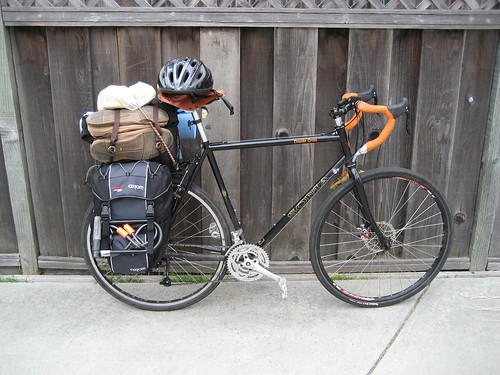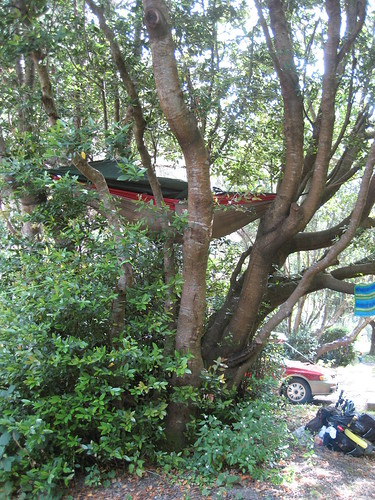I'd heard about hammock camping before this trip, but it seemed like a reasonable solution for this trip. I really was disinclined to sleep in a tent with a bunch of other people, and carrying a 1-man is pretty light, but expensive. So, I went with a Byer "Traveler" hammock, which cost me about $20. Add in another $12 for rope, and $2.50 for a 2.5mil 9x12 drop cloth, and my entire shelter cost less than a decent sleeping bag.
Better yet, it worked really well. Hammocks are easy to put up, the drop cloth kept my very dry, and it all packed away inside a pot. The drop cloth went under my sleeping bag on the rack to protect it from water off my tire. I was never cold, almost always comfortable, and didn't worry about the condition of the ground.
The one thing about the Traveler hammock is that it uses cords on the ends, which ended up tangling and causing the hammock to lie oddly. So I cut them off, knotted the ends, and used that. I'm 6'1" and there was still enough length to just barely fit me. But the snugness was good, and my sleep quality went back up.
The other downside is that there are times when there aren't trees available. I just threw down a ground cloth, put my sleeping bag on that and slept. If there was a wind or a chance of rain I put up the drop cloth, using my bike as a support. This works well unless there is a significant amount of rain, as it provides no protection from runoff.
Overall I think I was more comfortable and dryer than the tent campers. I certainly enjoyed the freedom of having a hammock, and feel that the benefits outweigh the (very few) downsides.
Kai and Hunter also used hammocks; Kai going for one slightly more complex than mine, and Hunter rocking a Hennessy. Both seemed to also have excellent experiences with their hammocks.
(Robert)
Thursday, October 22, 2009
Soma Double Cross: not really a touring bike.

I built up a Double Cross shortly before the tour, and since it was the closest thing to a touring bike I owned, I toured on it. Tossed a slimline Axiom rack on the back, and tried for some front panniers, but it just wasn't a good idea. The proximity of the bags to the rotor made me nervous. The rear rack required a bit of cleverness to mount, since it's a taller frame, a smaller rack, and the bike has pretty short chain stays. Once on, it didn't give me any trouble.
The chain stay length on the other hand became a reoccurring issue, not helped by the fact that I have pretty large feet, and long cranks. By moving the bags all the way back things worked out ok, but that put the entirety of my load on or behind the rear axle. Not exactly ideal, considering that the bike is pretty heavily rear loaded to start with.
That said, the handling wasn't terribly affected by this, and in actual use the main problem was a higher rate of rear punctures, and faster wear on the rear tire.
The short chain stays were nice in that the bike remained tight even when loaded, and shimmy or speed wobbles were never a major concern. If credit-card touring this frame would do nicely, as it's light enough to scoot up hills, but still stiff. Using a fork with eyelets for front panniers would help to even everything out weight wise.
Overall, the Double Cross worked well as an improvised touring bike, and I have no desire to swap it out for a more touring specific bike. That said, if you really want a touring specific frame, you might avoid the Double Cross.
(It's a cross bike, duh.)
(Robert)
Wednesday, October 21, 2009
Pacific Coast Corn
Corn on the cob, with a hint of the North Pacific. Sweet and salty, it goes great with some Pannier Pork and some Summer Grifter IPA. (My review.) John (up top) doesn't even like corn, and he liked this.
Ingredients:
Corn in the husks. However much you want to eat. Buy local.
The ocean. We use the North Pacific, as it's not as filled with terrible stuff as the water near SoCal is. Recommend Humboldt/Mendocino county or farther north.
A plastic bag, big enough to get all your corn in.
A beach, or a cliff and a little ingenuity.
Take the corn, leave the husk on. Put it in a bag, put the whole thing in the ocean. Let it soak for a good long while, at least 20 minutes. Do this in such a way as to minimize the sand in the corn. (Don't just throw it into the surf.) While the corn is soaking, get a good fire going, let it go to coal, and put the coals under the grate. Throw the corn on top of the grate, and let it cook till it's done, turning occasionally. Pull off the grate, husk, and eat. In that order. Add lime to taste.
(Robert)
Ingredients:
Corn in the husks. However much you want to eat. Buy local.
The ocean. We use the North Pacific, as it's not as filled with terrible stuff as the water near SoCal is. Recommend Humboldt/Mendocino county or farther north.
A plastic bag, big enough to get all your corn in.
A beach, or a cliff and a little ingenuity.
Take the corn, leave the husk on. Put it in a bag, put the whole thing in the ocean. Let it soak for a good long while, at least 20 minutes. Do this in such a way as to minimize the sand in the corn. (Don't just throw it into the surf.) While the corn is soaking, get a good fire going, let it go to coal, and put the coals under the grate. Throw the corn on top of the grate, and let it cook till it's done, turning occasionally. Pull off the grate, husk, and eat. In that order. Add lime to taste.
(Robert)
Subscribe to:
Comments (Atom)



